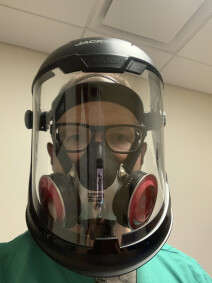On the Front Lines During Covid-19
I AM PALMER
I am Palmer is a series of articles written by parishioners at Palmer Memorial Episcopal Church about their experiences in the time of COVID-19. With a close proximity to the Texas Medical Center and Rice University, the Palmer community has a unique insight into the halls of hospitals and laboratories. In this series, we will hear from a research pharmacy technician, an epidemiologist, an elder care professional, an ER doctor, and doctor parents, all serving in different ways on the front lines of this virus.
 I am an ICU physician working on the "front lines" during this health crisis. Although I am accustomed to dealing with critically ill people, the current pandemic has presented a new set of challenges that has shaken and redefined the health care community. In our increasingly connected world, we saw in real-time via social media as friends and colleagues in Italy, then New York, encountered an overwhelming surge of patients hitting their hospitals, shortages of supplies, and overflowing morgues. The anxiety about our own preparedness began. Would we, too, be overrun?
I am an ICU physician working on the "front lines" during this health crisis. Although I am accustomed to dealing with critically ill people, the current pandemic has presented a new set of challenges that has shaken and redefined the health care community. In our increasingly connected world, we saw in real-time via social media as friends and colleagues in Italy, then New York, encountered an overwhelming surge of patients hitting their hospitals, shortages of supplies, and overflowing morgues. The anxiety about our own preparedness began. Would we, too, be overrun?
We had protocol and plans set up, but none of it seemed real until the COVID-19 patients started showing up. The available evidence on how to best manage these patients was sparse, largely anecdotal, and changed by the day, but we had daily meetings to share our experiences and refine our treatment protocols, guided by the latest evidence.
We converted one of our ICUs into a COVID-19 unit. Before entering the rooms of the sickest patients, I had to wash my hands, put on a gown, put on a special mask, then put on a face shield. After examining and visiting with the patient, the "doffing procedure" began, which consisted of removing this gear in precisely the right order and with proper technique - step-by-step videos were provided by our hospital to ensure that everyone applied and removed this gear as safely as possible in order to limit the spread of this disease.
No visitors could be permitted in these rooms, and anyone who entered the room was fully "suited-up" with the gear mentioned above. Our best efforts to comfort our suffering fellow human beings were curtailed by the inability to communicate in the normal fashion - our facial expressions were hard to make out through the protective gear, and verbal communication was limited due to the gear and the noise of the filtering fans. In the throes of critical illness, the best we could offer in terms of family contact was regular phone updates from the nurse and physicians and video conferencing between the patients and their loved ones.
It is difficult to see someone suffering and not be able to offer a clearly-heard word of encouragement, a comforting touch, or the presence of a loved one. Heading home, we have each established our own rituals of decontamination - immediate showers, wiping down all belongings with bleach. We scrub clean our hair and skin, but the memories of our patients, alone in white rooms, surrounded by caring, but unrecognizable people, are not so easy to wipe away.

Comments
Login/Register to leave a comment